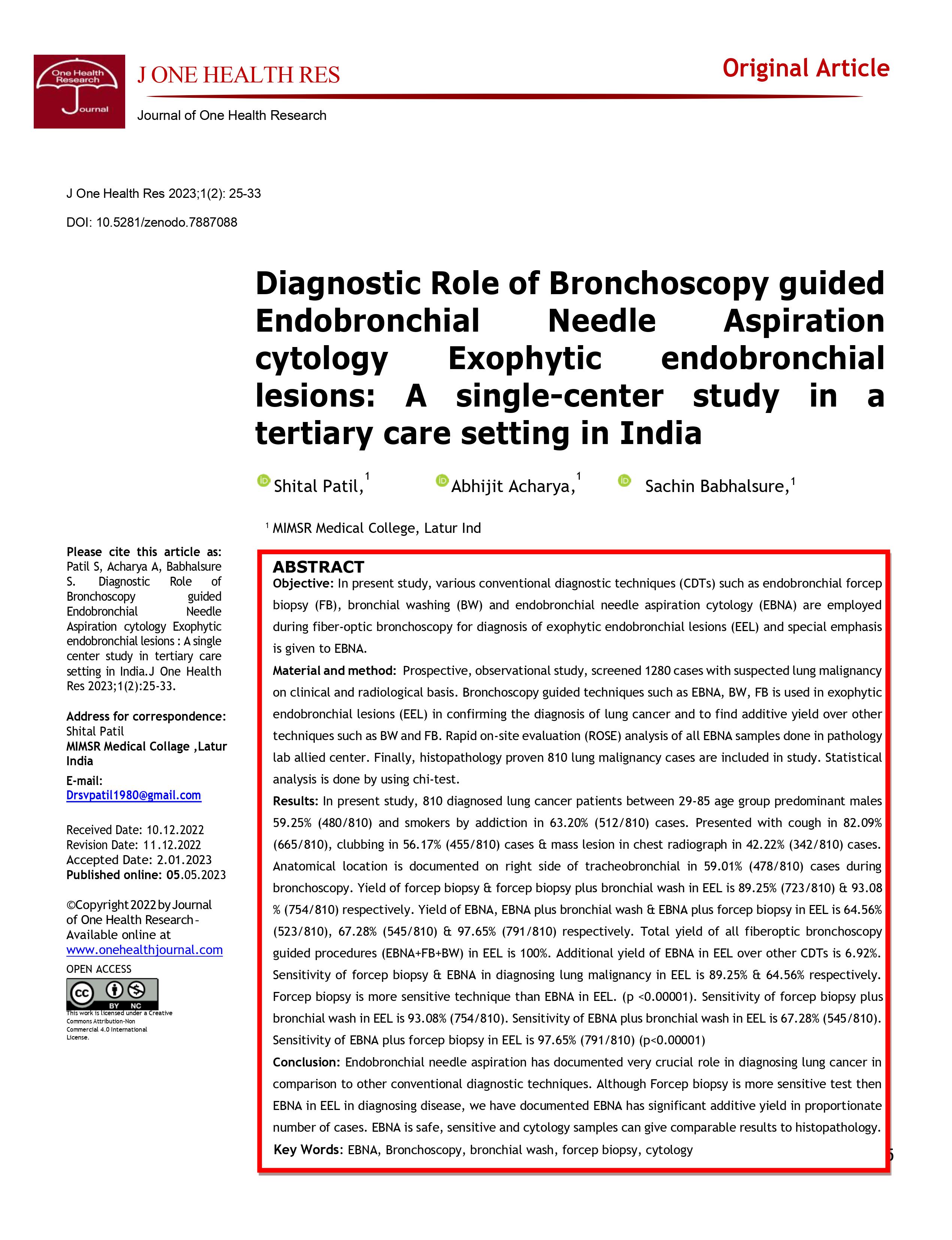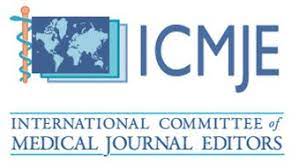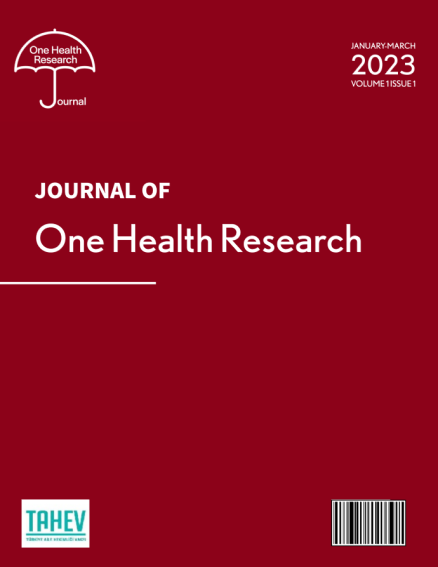Diagnostic Role of Bronchoscopy guided Endobronchial Needle Aspiration cytology Exophytic endobronchial lesions: A single-center study in a tertiary care setting in India
Diagnostic Role of Bronchoscopy guided Endobronchial Needle Aspiration cytology
DOI:
https://doi.org/10.5281/zenodo.7887088Özet
Objective: In present study, various conventional diagnostic techniques (CDTs) such as endobronchial forcep biopsy (FB), bronchial washing (BW) and endobronchial needle aspiration cytology (EBNA) are employed during fiber-optic bronchoscopy for diagnosis of exophytic endobronchial lesions (EEL) and special emphasis is given to EBNA.
Material and method: Prospective, observational study, screened 1280 cases with suspected lung malignancy on clinical and radiological basis. Bronchoscopy guided techniques such as EBNA, BW, FB is used in exophytic endobronchial lesions (EEL) in confirming the diagnosis of lung cancer and to find additive yield over other techniques such as BW and FB. Rapid on-site evaluation (ROSE) analysis of all EBNA samples done in pathology lab allied center. Finally, histopathology proven 810 lung malignancy cases are included in study. Statistical analysis is done by using chi-test.
Results: In present study, 810 diagnosed lung cancer patients between 29-85 age group predominant males 59.25% (480/810) and smokers by addiction in 63.20% (512/810) cases. Presented with cough in 82.09% (665/810), clubbing in 56.17% (455/810) cases & mass lesion in chest radiograph in 42.22% (342/810) cases. Anatomical location is documented on right side of tracheobronchial in 59.01% (478/810) cases during bronchoscopy. Yield of forcep biopsy & forcep biopsy plus bronchial wash in EEL is 89.25% (723/810) & 93.08
% (754/810) respectively. Yield of EBNA, EBNA plus bronchial wash & EBNA plus forcep biopsy in EEL is 64.56% (523/810), 67.28% (545/810) & 97.65% (791/810) respectively. Total yield of all fiberoptic bronchoscopy guided procedures (EBNA+FB+BW) in EEL is 100%. Additional yield of EBNA in EEL over other CDTs is 6.92%. Sensitivity of forcep biopsy & EBNA in diagnosing lung malignancy in EEL is 89.25% & 64.56% respectively. Forcep biopsy is more sensitive technique than EBNA in EEL. (p <0.00001). Sensitivity of forcep biopsy plus bronchial wash in EEL is 93.08% (754/810). Sensitivity of EBNA plus bronchial wash in EEL is 67.28% (545/810).Sensitivity of EBNA plus forcep biopsy in EEL is 97.65% (791/810) (p<0.00001)
Conclusion: Endobronchial needle aspiration has documented very crucial role in diagnosing lung cancer in comparison to other conventional diagnostic techniques. Although Forcep biopsy is more sensitive test then EBNA in EEL in diagnosing disease, we have documented EBNA has significant additive yield in proportionate number of cases. EBNA is safe, sensitive and cytology samples can give comparable results to histopathology.
Referanslar
F. Bray, J. Ferlay, I. Soerjomataram, R.L. Siegel, L.A. Torre, A. Jemal. Global cancer statistics 2018: GLOBOCAN estimates of
incidence and mortality worldwide for cancers in 185 countries. CA Cancer J Clin, 68 (2018), pp. 394-424
ES Edell. Future therapeutic procedures Chest Surg Clin N Am, 6 (1996), pp. 381-395
S Ikeda, N Yanai, S Ishikawa Flexible bronchofiberscope Keio J Med, 17 (1968), pp. 1-16
Lee P, Colt HG. Bronchoscopy in lung cancer appraisal of current technology and for the future. J Thorac Oncol 2010; 5: 1290–1300.
Dasgupta A, Minai OA, Mehta AC: Transbronchial needle aspiration of central and peripheral lesions; in Bollinger CT, Mathur PN
(eds): Interventional bronchoscopy. Basel Karger, 2000, pp 66-70
Govert JA, Dodd LG, Kussin PS,Samuelson, WM Cancer. A prospective comparison of fiberoptic transbronchial needle
aspiration and bronchial biopsy for bronchoscopically visible lung carcinoma. 1999 Jun 25; 87(3):129-34
Mazzone P, Jain P, Arroliga AC, Matthay RA: Bronchoscopy and Needle aspiration techniques for diagnosis and staging of lung
cancer. Clin Chest Med 2002; 23:137-158
Bilaceroglu S, Gunel O, Cagirici U, Perim K: Comparisn of endobronchial needle aspiration with forcep and brush biopsies in the diagnosis of endobronchial cancer. Monaldi Arch Chest Dis 1997; 52:13-17
Lachman MF, Schofield K and Cellura K. (1999): Bronchoscopic diagnosis of malignancy in the lower airway: A cytologic review. Acta Cytol 1999; 39:1148 -51
Haponick EF, Cappelari JO, Chin R, Alford PT, Bowton DL: education and experience improves transbronchial needle aspiration performance. Am J Resp Crit Care Med 1995; 151:1998-2002
Patil Shital and Ayachit Rujuta. "‘Bronchoscopic Characterization of Lesions’: Significant impact on lung cancer diagnosis with use
of Transbronchial needle aspiration (TBNA) in Comparison to conventional diagnostic techniques (CDTs)." Clinical Cancer Investigation Journal, vol. 6, no. 6, Nov.-Dec. 2017, p. 239
Shital P, Rujuta A, Sanjay M. Transbronchial needle aspiration cytology (TBNA) in endobronchial lesions: a valuable technique during bronchoscopy in diagnosing lung cancer and it will decrease repeat bronchoscopy. J Cancer Res Clin Oncol. 2014 May;140(5):809-15
Kacar N., Tuksavul F., Edipoglu O., Ermete S., Guclu S.Z. Effectiveness of transbronchial needle aspiration in the diagnosis of exophytic endobronchial lesions and submucosal/peribronchial diseases of the lung (2005) Lung Cancer, 50 (2) , pp. 221-226
Conley YD, Cafoncelli AR, Khan JH, et al. Bronchial carcinoid tumor: experience over 20 years. Am Surg 1992;58:670-2.
Jones DF, Chin R, Jr, Cappellari JO, et al. Endobronchial needle aspiration in the diagnosis of small-cell carcinoma. Chest 1994;105:1151-4
Popovich J, Jr, Kvale PA, Eichenhorn MS, et al. Diagnostic accuracy of multiple biopsies from flexible fiberoptic bronchoscopy. A comparison of central versus peripheral carcinoma. Am Rev Respir Dis 1982;125:521-3
Salathe M, Soler M, Bolliger CT et al Transbronchial needle aspiration in routine fiberoptic bronchoscopy. Respiration 1992.
:5–8
J.A. Gullón, R. Fernández, A. Medina, G. Rubinos, I. Suárez, C. Ramos, and I.J. González Transbronchial Needle Aspiration in
Bronchogenic Carcinoma with Visible Lesions: Diagnostic Yield and Cost Arch Bronconeumol 2003;39(11):496-500
Caglayan B, Akturk UA, Fidan A, Salepci B et al. Transbronchial needle aspiration in the diagnosis of endobronchial malignant lesions. Chest 2005. 128(2):704–708
Gellert AR, Rudd RM, Sinha G, Geddes DM Fiberoptic bronchoscopy: effect of experience of operator on diagnostic yield of bronchial
biopsy in bronchial carcinoma. Br J Dis Chest 1982. 76:397–399
Ernst A, Silvestri GA, Johnstone D. Interventional pulmonary procedures: guidelines from the American College of Chest
Physicians. Chest 2003. 123:1693–1717
Karahalli E, Yilmaz A, Türker H, Ozvaran K et al Usefulness of various diagnostic techniques during fiberoptic bronchoscopy for
endoscopically visible tumours Respiration 2001. 68(6):611–614
Siddiqui MT, Saboorian MH, Gokaslan ST et al. The utility of transbronchial (Wang) fine needle aspiration in lung cancer diagnosis.
Cytopathology 2002 12:7–1482
Verma SK, Shrivastav AN, Prasad R Study of fiberoptic bronchoscope in endoscopically visible bronchial carcinoma. Int Infect Dis 2011 1:7
Roth K, Hardie JA, Andreassen AH, Leh F, Eagan TM et al. Predictors of diagnostic yield in bronchoscopy: a retrospective cohort study
comparing different combinations of sampling techniques. BMC Pulm Med 2008. 26(8):2
Lundgren R, Bergman F, Angstrom T: Comparison of transbronchial fine needle aspiration biopsy, aspiration of bronchial secretions, bronchial washing, brush biopsy and forceps biopsy in the diagnosis of lung cancer. Eur J Respir Dis 1983;64:378–385.
Shure D, Fedullo PF: Transbronchial needle aspiration in the diagnosis of submucosal and peribronchial bronchogenic carcinoma. Chest 1985;88:49–51
Mondoni M, Carlucci P, Di Marco F, et al. Rapid on-site evaluation improves needle aspiration sensitivity in the diagnosis of central lung cancers: a randomized trial. Respiration 2013;86:52-8. 10.1159/000346998
Bollinger CT, Plekker D, Koegelenberg CFN (2010) Different techniques in bronchoscopy. Eur Respir Mon 2010.45:1–17
Jin F, Mu D, Chu D et al. Severe complications of bronchoscopy. Respiration 2008. 76:429–43

İndir
Yayınlanmış
Nasıl Atıf Yapılır
Sayı
Bölüm
Lisans
Telif Hakkı (c) 2023 Journal of One Health Research

Bu çalışma Creative Commons Attribution 4.0 International License ile lisanslanmıştır.




